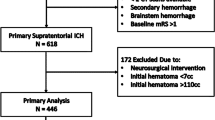Abstract
Background
Plasma expansion in acute ischemic stroke has potential to improve cerebral perfusion, but the long-term effects on functional outcome are mixed in prior trials. The goal of this study was to evaluate how the magnitude of plasma expansion affects neurological recovery in acute stroke.
Methods
This was a secondary analysis of data from the Albumin in Acute Stroke Part 2 trial investigating the relationship between the magnitude of overall intravenous volume infusion (crystalloid and colloid) to clinical outcome. The data were inclusive of 841 patients with a mean age of 64 years and a median National Institutes of Health Stroke Scale (NIHSS) of 11. In a multivariable-adjusted logistic regression model, this analysis tested the volume of plasma expansion over the first 48 h of hospitalization as a predictor of favorable outcome, defined as either a modified Rankin Scale score of 0 or 1 or a NIHSS score of 0 or 1 at 90 days. This model included all study patients, irrespective of albumin or isotonic saline treatment.
Results
Patients that received higher volumes of plasma expansion more frequently had large vessel ischemic stroke and higher NIHSS scores. The multivariable-adjusted model revealed that there was decreased odds of a favorable outcome for every 250 ml additional volume plasma expansion over the first 48 h (OR 0.91, 95 % CI, 0.88–0.94).
Conclusions
The present study demonstrates an association between greater volume of plasma expansion and worse neurological recovery.
Similar content being viewed by others
References
Goslinga H, Eijzenbach V, Heuvelmans JH, et al. Custom-tailored hemodilution with albumin and crystalloids in acute ischemic stroke. Stroke. 1992;23:181–8.
Rodriguez GJ, Cordina SM, Vazquez G, et al. The hydration influence on the risk of stroke (THIRST) study. Neurocrit Care. 2009;10:187–94.
Bhalla A, Sankaralingam S, Dundas R, Swaminathan R, Wolfe CDA, Rudd AG. Influence of raised plasma osmolality on clinical outcome after acute stroke. Stroke. 2000;31:2043–8.
Schrock JW, Glasenapp M, Drogell K. Elevated blood urea nitrogen/creatinine ratio is associated with poor outcome in patients with ischemic stroke. Clin Neurol Neurosurg. 2012;114:881–4.
Chang TS, Jensen MB. Haemodilution for acute ischaemic stroke. Cochrane Database Syst Rev. 2014;8:CD000103.
Ginsberg MD, Palesch YY, Hill MD, et al. High-dose albumin treatment for acute ischaemic stroke (ALIAS) Part 2: a randomised, double-blind, phase 3, placebo-controlled trial. Lancet Neurol. 2013;12:1049–58.
Hill MD, Moy CS, Palesch YY, et al. The albumin in acute stroke trial (ALIAS); design and methodology. Int J Stroke. 2007;2:214–9.
Pexman JH, Barber PA, Hill MD, et al. Use of the Alberta Stroke Program Early CT Score (ASPECTS) for assessing CT scans in patients with acute stroke. AJNR Am J Neuroradiol. 2001;22:1534–42.
Aviv RI, Mandelcorn J, Chakraborty S, et al. Alberta Stroke Program Early CT Scoring of CT perfusion in early stroke visualization and assessment. AJNR Am J Neuroradiol. 2007;28:1975–80.
Kellert L, Martin E, Sykora M, et al. Cerebral oxygen transport failure?: Decreasing hemoglobin and hematocrit levels after ischemic stroke predict poor outcome and mortality: STroke: RelevAnt Impact of hemoGlobin, Hematocrit and Transfusion (STRAIGHT)—an observational study. Stroke. 2011;42:2832–7.
Fink JN, Selim MH, Kumar S, et al. Is the association of National Institutes of Health Stroke Scale scores and acute magnetic resonance imaging stroke volume equal for patients with right- and left-hemisphere ischemic stroke? Stroke. 2002;33:954–8.
Liebeskind DS. Hydration and collateral flow in acute stroke. Eur J Neurol. 2016;23:433–4.
Acknowledgments
The open access data set for the ALIAS 2 trial was provided by the National Institute for Neurological Disorders and Stroke.
Funding
Robert Welch has received NIH/NINDS funding.
Author information
Authors and Affiliations
Corresponding author
Ethics declarations
Conflict of interest
Joseph B. Miller, Christopher Lewandowski, Charles R. Wira, Andrew Taylor and Charlotte Burmeister report no conflicts of interest.
Rights and permissions
About this article
Cite this article
Miller, J.B., Lewandowski, C., Wira, C.R. et al. Volume of Plasma Expansion and Functional Outcomes in Stroke. Neurocrit Care 26, 191–195 (2017). https://doi.org/10.1007/s12028-016-0316-0
Published:
Issue Date:
DOI: https://doi.org/10.1007/s12028-016-0316-0




